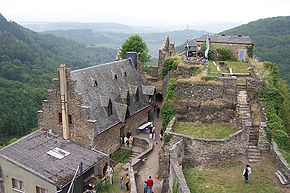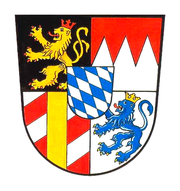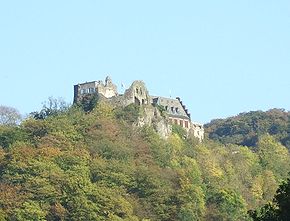
Veldenz
Encyclopedia

Municipalities of Germany
Municipalities are the lowest level of territorial division in Germany. This may be the fourth level of territorial division in Germany, apart from those states which include Regierungsbezirke , where municipalities then become the fifth level.-Overview:With more than 3,400,000 inhabitants, the...
belonging to a Verbandsgemeinde
Verbandsgemeinde
A Verbandsgemeinde is an administrative unit in the German Bundesländer of Rhineland-Palatinate and Saxony-Anhalt.-Rhineland-Palatinate:...
, a kind of collective municipality – in the Bernkastel-Wittlich
Bernkastel-Wittlich
Bernkastel-Wittlich is a district in Rhineland-Palatinate, Germany. It is bounded by the districts of Vulkaneifel, Cochem-Zell, Rhein-Hunsrück, Birkenfeld, Trier-Saarburg and Bitburg-Prüm.- History :...
district
Districts of Germany
The districts of Germany are known as , except in the states of North Rhine-Westphalia and Schleswig-Holstein where they are known simply as ....
in Rhineland-Palatinate
Rhineland-Palatinate
Rhineland-Palatinate is one of the 16 states of the Federal Republic of Germany. It has an area of and about four million inhabitants. The capital is Mainz. English speakers also commonly refer to the state by its German name, Rheinland-Pfalz ....
, Germany
Germany
Germany , officially the Federal Republic of Germany , is a federal parliamentary republic in Europe. The country consists of 16 states while the capital and largest city is Berlin. Germany covers an area of 357,021 km2 and has a largely temperate seasonal climate...
. It is the former main seat of the County of Veldenz, once a prominent principality to which belonged 120 villages and towns now in Rhineland-Palatinate and northern Alsace
Alsace
Alsace is the fifth-smallest of the 27 regions of France in land area , and the smallest in metropolitan France. It is also the seventh-most densely populated region in France and third most densely populated region in metropolitan France, with ca. 220 inhabitants per km²...
.
Location
The municipality lies in the Middle MoselleMittelmosel
The name Mittelmosel refers to the approximately 120-kilometer section of the river Moselle, in the state of Rhineland-Palatinate in Germany from the city of Trier to Zell...
region of valley country marked by even slopes and former oxbows of the Moselle. Veldenz is found on the Moselle’s right bank, but does not lie right at the water’s edge, but rather some two kilometres back from the river, under the outermost forests of the Hunsrück
Hunsrück
The Hunsrück is a low mountain range in Rhineland-Palatinate, Germany. It is bounded by the river valleys of the Moselle , the Nahe , and the Rhine . The Hunsrück is continued by the Taunus mountains on the eastern side of the Rhine. In the north behind the Moselle it is continued by the Eifel...
. Roughly 850 ha of the 1 441 ha municipal area is wooded. About 130 ha is given over to winegrowing.
Veldenz belongs to the Verbandsgemeinde of Bernkastel-Kues, whose seat is in the like-named town
Bernkastel-Kues
Bernkastel-Kues is a well-known winegrowing centre on the Middle Moselle in the Bernkastel-Wittlich district in Rhineland-Palatinate, Germany...
.
Nearby municipalities
Neighbouring municipalities are, among others, BurgenBurgen, Bernkastel-Wittlich
Burgen is an Ortsgemeinde – a municipality belonging to a Verbandsgemeinde, a kind of collective municipality – in the Bernkastel-Wittlich district in Rhineland-Palatinate, Germany.- Location :...
and Mülheim
Mülheim an der Mosel
Mülheim is an Ortsgemeinde – a municipality belonging to a Verbandsgemeinde, a kind of collective municipality – in the Bernkastel-Wittlich district in Rhineland-Palatinate, Germany.- Location :...
. The nearest middle centres
Central Place Theory
Central place theory is a geographical theory that seeks to explain the number, size and location of human settlements in an urban system. The theory was created by the German geographer Walter Christaller, who asserted that settlements simply functioned as 'central places' providing services to...
are Bernkastel-Kues
Bernkastel-Kues
Bernkastel-Kues is a well-known winegrowing centre on the Middle Moselle in the Bernkastel-Wittlich district in Rhineland-Palatinate, Germany...
, some 10 km away, and Wittlich
Wittlich
The town of Wittlich is the seat of the Bernkastel-Wittlich district in Rhineland-Palatinate, Germany, and thereby the middle centre for a feeder area of 56 municipalities in the Eifel and Moselle area with its population of roughly 64,000...
, some 17 km away. Trier
Trier
Trier, historically called in English Treves is a city in Germany on the banks of the Moselle. It is the oldest city in Germany, founded in or before 16 BC....
lies some 45 km away.
Climate
Veldenz lies within the temperate zone; compared to other regions in Germany, a very warm and sunny climate prevails here. In neighbouring BraunebergBrauneberg
Brauneberg is an Ortsgemeinde – a municipality belonging to a Verbandsgemeinde, a kind of collective municipality – in the Bernkastel-Wittlich district in Rhineland-Palatinate, Germany. It is known above all for its wine and its meteorological distinctions.- Location :The municipality lies on the...
on 11 August 1998, a record temperature of 41.2 °C in the shade, the highest ever air temperature recorded in the Federal Republic, was confirmed. Because of its location alee of the Eifel
Eifel
The Eifel is a low mountain range in western Germany and eastern Belgium. It occupies parts of southwestern North Rhine-Westphalia, northwestern Rhineland-Palatinate and the south of the German-speaking Community of Belgium....
, precipitation
Precipitation (meteorology)
In meteorology, precipitation In meteorology, precipitation In meteorology, precipitation (also known as one of the classes of hydrometeors, which are atmospheric water phenomena is any product of the condensation of atmospheric water vapor that falls under gravity. The main forms of precipitation...
from northwest weather systems is often kept away. Ongoing evaporation of water from the Moselle regularly leads to high humidity, which, especially in summer, makes at times for heavy and muggy weather, and which also brings many storms along with it.
History
As early as 500 BC, the TreveriTreveri
The Treveri or Treviri were a tribe of Gauls who inhabited the lower valley of the Moselle from around 150 BCE, at the latest, until their eventual absorption into the Franks...
, a people of mixed Celtic and Germanic
Germanic peoples
The Germanic peoples are an Indo-European ethno-linguistic group of Northern European origin, identified by their use of the Indo-European Germanic languages which diversified out of Proto-Germanic during the Pre-Roman Iron Age.Originating about 1800 BCE from the Corded Ware Culture on the North...
stock, from whom the Latin
Latin
Latin is an Italic language originally spoken in Latium and Ancient Rome. It, along with most European languages, is a descendant of the ancient Proto-Indo-European language. Although it is considered a dead language, a number of scholars and members of the Christian clergy speak it fluently, and...
name for the city of Trier
Trier
Trier, historically called in English Treves is a city in Germany on the banks of the Moselle. It is the oldest city in Germany, founded in or before 16 BC....
, Augusta Treverorum
History of Trier
Trier in Rhineland-Palatinate, whose history dates to the Roman Empire, is often claimed to be the oldest city in Germany. Traditionally it was known in English by its French name of Treves.- Prehistory :...
, is also derived, settled in Veldenz’s fertile valley. After them, from about 50 BC to AD 500 came the Romans
Ancient Rome
Ancient Rome was a thriving civilization that grew on the Italian Peninsula as early as the 8th century BC. Located along the Mediterranean Sea and centered on the city of Rome, it expanded to one of the largest empires in the ancient world....
. Possibly about the year 1129, Gerlach I built a castle, today’s Schloss Veldenz
Schloss Veldenz
Schloss Veldenz in the Mosel Valley region is a Castle ruin about 1.5 kilometers southeast of Veldenz.-Location:The site is located in the Rhineland-Palatinate in the county of Bernkastel-Wittlich...
. In 1286, Rudolph of Habsburg
Rudolph I of Germany
Rudolph I was King of the Romans from 1273 until his death. He played a vital role in raising the Habsburg dynasty to a leading position among the Imperial feudal dynasties...
granted Veldenz town and market rights. By 1444, the castle and its environs had passed to the Counts of Palatinate-Zweibrücken
Palatinate-Zweibrücken
Palatinate-Zweibrücken is a former state of the Holy Roman Empire. Its capital was Zweibrücken.-Overview:→ History before 1394 see main article County of Zweibrücken→ History before 1444 see main article County of Veldenz...
, or between 1543 and 1694 the Principality of Palatinate-Veldenz. In 1752, in Burgen
Burgen, Bernkastel-Wittlich
Burgen is an Ortsgemeinde – a municipality belonging to a Verbandsgemeinde, a kind of collective municipality – in the Bernkastel-Wittlich district in Rhineland-Palatinate, Germany.- Location :...
near Veldenz, the widely known robber Johann Peter Petri, also known as Schwarzer Peter (“Black Peter”), was born. From 1777 to 1797, Veldenz belonged to Bavaria
Bavaria
Bavaria, formally the Free State of Bavaria is a state of Germany, located in the southeast of Germany. With an area of , it is the largest state by area, forming almost 20% of the total land area of Germany...
. In 1835 the Veldenz Lion was adopted as the Bavarian Lion in that kingdom’s coat of arms. Even today, many examples of comital building undertakings from the 18th century can be found, among them the town hall.
Municipal council
The council is made up of 12 council members, who were elected at the municipal election held on 7 June 2009. The mayor is Norbert Sproß.
| Freie Wählergruppe Veldenz e.V. | Freie Wählergruppe Bauer | Total | |
| 2009 | 7 | 5 | 12 seats |
Coat of arms
The municipality’s armsCoat of arms
A coat of arms is a unique heraldic design on a shield or escutcheon or on a surcoat or tabard used to cover and protect armour and to identify the wearer. Thus the term is often stated as "coat-armour", because it was anciently displayed on the front of a coat of cloth...
might be described thus: Bendy lozengy argent and azure, in dexter chief an inescutcheon of the first charged with a lion rampant of the second armed and langued gules.
The lion in the inescutcheon is the heraldic charge
Charge (heraldry)
In heraldry, a charge is any emblem or device occupying the field of an escutcheon . This may be a geometric design or a symbolic representation of a person, animal, plant, object or other device...
once borne by the Counts of Veldenz, and the “bendy lozengy” pattern seen on the field is the Wittelsbach dynasty’s armorial bearing. In 1835, this lion was adopted by Ludwig I, King of Bavaria
Ludwig I of Bavaria
Ludwig I was a German king of Bavaria from 1825 until the 1848 revolutions in the German states.-Crown prince:...
into that kingdom’s state coat of arms, where it remained as a charge until the end of the First World War when the last Bavarian king, Ludwig III
Ludwig III of Bavaria
Ludwig III , was the last King of Bavaria, reigning from 1913 to 1918.-Early life:...
was forced to abdicate as a result of the November Revolution.
Village culture
In 1993 and 1995, Veldenz won the silver medal of the Federal Republic in the contest Unser Dorf soll schöner werden (“Our village should become lovelier”); in 2006, the villagers managed to triumph once again in the district and regional contest. In the vineyard locations of Elisenberg, Kirchberg, Mühlberg, Grafschafter Sonnenberg and Carlsberg, there is winegrowing. There still exist today in the municipality about a dozen wineries; RieslingRiesling
Riesling is a white grape variety which originated in the Rhine region of Germany. Riesling is an aromatic grape variety displaying flowery, almost perfumed, aromas as well as high acidity. It is used to make dry, semi-sweet, sweet and sparkling white wines. Riesling wines are usually varietally...
is the customary variety.
Sightseeing

Schloss Veldenz
Schloss Veldenz in the Mosel Valley region is a Castle ruin about 1.5 kilometers southeast of Veldenz.-Location:The site is located in the Rhineland-Palatinate in the county of Bernkastel-Wittlich...
. There are other monumental buildings, such as the town hall, a signal tower from the 12th century, a mint, a Celtic wall and museums with various exhibits. Further points of interest are an historical market (Krammarkt), a farmer’s garden (Bauerngarten), a wild garden, the Josefinenhöhe (heights), the Pionierfelsen (cliff), many ore and slate mines, the Roter Bohles leisure complex and many imposing cliff formations.
Economy and infrastructure
Winegrowing and tourismTourism
Tourism is travel for recreational, leisure or business purposes. The World Tourism Organization defines tourists as people "traveling to and staying in places outside their usual environment for not more than one consecutive year for leisure, business and other purposes".Tourism has become a...
play a prominent rôle. In Veldenz there are two village squares, three community houses, a village hall, several barbecue pits, educational paths dealing with both wine and the forest, a memorial, a graveyard, two churches and a sporting ground. Furthermore, Veldenz also has its own primary school, a kindergarten
Kindergarten
A kindergarten is a preschool educational institution for children. The term was created by Friedrich Fröbel for the play and activity institute that he created in 1837 in Bad Blankenburg as a social experience for children for their transition from home to school...
, a youth centre, a football field and four children’s playgrounds. In the village is also a regional children’s and youth home. Roughly 45 km of hiking trails lead around the village. Public transport in Veldenz is integrated into the Verkehrsverbund Region Trier (VRT), whose fares therefore apply.
Further reading
- Ernst Probst: Der Schwarze Peter. Ein Räuber im Hunsrück und Odenwald. Probst, Mainz-Kostheim 2005, ISBN 3-936326-39-8
- Theodor Gümbel: Geschichte des Fürstentums Pfalz-Veldenz. E. Grusius, Kaiserslautern 1900.

